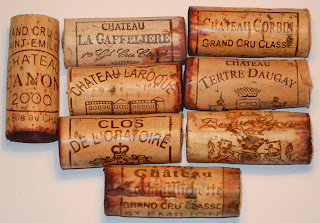Na
última 5ª feira, dia 16 de agosto, realizamos mais uma excelente degustação no Rosmarino,
com a presença de 8 confrades. Foram degustados 8 vinhos, das safras 1996,
1997, 1998, 2000 e 2004, sendo tres Premier Grand Cru Classé e cinco Grand Cru
Classé, segundo a classificação de 1996. Como de costume, o nosso menu foi
escolhido pelo nosso confrade Paulo e harmonizou muito bem com os vinhos
degustados.
Couvert:
Pão italiano, mini-ciabata, pão de queijo, patê de roquefort, manteiga e
azeitona chilena.
Entradas: Sopa
de Cebola.
Prato principal: Entrecote
ao molho de mostarda de Dijon e batatas coradas ao alecrim.
Sobremesa: Entremet
de chocolate, Torta de nozes carameladas, Merengue de chocolate belga e avelãs,
Carolinas de creme, Ovos nevados, Profiteroles, Terrine de Frutas, Tiramisú,
Creme brulée, Pastiera di grano, Bavarese de chocolate e Tarte Tatin
Como
de costume, o ambiente, a comida e o serviço estavam excelentes..
A
degustação contou com oito vinhos, com níveis alcoólicos variando entre 12,5% e
14%.
A
seguir uma breve descrição dos vinhos degustados:
Chateau
Canon 2000
Produtor: Chateau Canon
País/Região: França/Saint Emilion
Graduação alcoolica: 13.5%
Uvas: Bordeaux Blend/Margem Direita
Confrade: Marcio
Chateau
Laroque 2004
Produtor: Beaumartin
País/Região: França/Saint Emilion
Graduação alcoolica: 13.5%
Uvas: Bordeaux Blend/Margem Direita
Confrade: Paulo
Clos
de L'Oratoire 1998
Produtor: Comtes de Neipperg
País/Região: França/Saint Emilion
Graduação alcoolica: 13.5%
Uvas: Bordeaux Blend/Margem Direita
Confrade: Alessandro
Chateau
La Gaffeliere 1997
Produtor: Malett Roquefort
País/Região: França/Saint Emilion
Graduação alcoolica: 13%
Uvas: Bordeaux Blend/Margem Direita
Confrade: Joubert
Chateau
Corbin 2004
Produtor: Chateau Corbin
País/Região: França/Saint Emilion
Graduação alcoolica: 13.5%
Uvas: Bordeaux Blend/Margem Direita
Confrade: Ricardo
Chateau
Corbin Michotte 1996
Produtor: Jean-Noel Boidron
País/Região: França/Saint Emilion
Graduação alcoolica: 12.5%
Uvas: Bordeaux Blend/Margem Direita
Confrade: Altman
Chateau
Tertre Daugay 2000
Produtor: Chateau Tertre Daugay
País/Região: França/Saint Emilion
Graduação alcoolica: 13%
Uvas: Bordeaux Blend/Margem Direita
Confrade: Alberto
Chateau
Beau Sejour Becot 2004
Produtor: Ch. Beau Sejour Becot
País/Região: França/Saint Emilion
Graduação alcoolica: 14%
Uvas: Bordeaux Blend/Margem Direita
Confrade: Joao Luiz
Vinhos
degustados
Saint-Émilion
é uma appellation d'origine contrôlée (AOC ) e uma das principais denominações
de vinhos tintos de Bordeaux. Situada na
sub-região de Libourne, na margem direita do Dordogne, possue 5.400 hectares (6%
do total de Bordeaux) nas comunas de Saint-Émilion,
Saint-Christophe-des-Bardes, Saint-Hippolyte, Saint-Étienne-de-Lisse,
Saint-Laurent-des-Combes, Saint-Pey-d'Armens, Saint-Sulpice-de-Faleyrens,
Vignonet, e Libourne.
A
região é muito menor do que o Médoc e adjacente a Pomerol. Como em Pomerol e em
outras denominações da margem direita do Gironde, as principais variedades de
uvas utilizadas são a Merlot e Cabernet Franc, com quantidades relativamente
pequenas de Cabernet Sauvignon.
Nesta
degustação, os resultados do nosso painel apresentaram, uma amplitude de notas bastante
reduzida, sendo na média aparada de 3,3 pontos (de 88,0 a 91,3).
O
vinho que ficou em último lugar foi o Chateau
Corbin Grand Cru Classé 2004, produzido pelo próprio Chateau Corbin na comuna
de Saint Emilion, com 13,5% de alcool, escolhido o pior vinho por cinco confrades
e o melhor por um.
O
segundo melhor vinho do painel, foi o Clos
de L’Oratoire Grand Cru Classé 1998, produzido pelos Comtes de Neipperg em Saint
Emilion. Este vinho, com 13,5% de alcool, foi considerado o segundo melhor
vinho por 3 confrades e o melhor para outros dois.
O
Campeão da noite, foi o Chateau Canon
Premier Grand Cru Classé 2000, produzido pelo Chateau Canon na comuna de Saint
Emilion, que ficou em primeiro lugar para 5 confrades.
Vejam
os resultados completos abaixo.
Não
se esquecam que o nosso próximo encontro será no dia 20/Setembro, quando
degustaremos Tintos top de corte bordalês ao redor do mundo até 2004. Até
lá....
Não
percam a próxima degustação.












